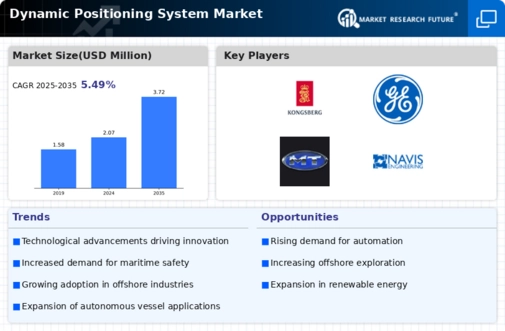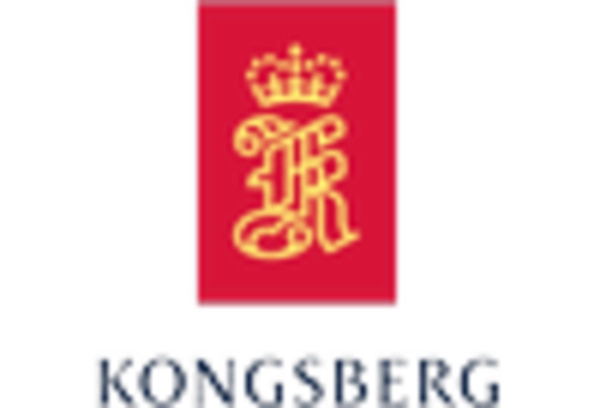Growth of Autonomous Marine Vehicles
The growth of autonomous marine vehicles is a significant driver for the Dynamic Positioning System Market. As the maritime sector increasingly embraces automation, the demand for sophisticated positioning systems that can support autonomous operations is rising. These vehicles require precise positioning capabilities to navigate safely and efficiently, particularly in complex marine environments. Recent estimates indicate that the market for autonomous vessels could reach 50 billion dollars by 2030, highlighting the potential for dynamic positioning systems to play a crucial role in this transformation. The integration of dynamic positioning technology into autonomous vessels not only enhances operational efficiency but also reduces the need for human intervention, thereby reshaping the dynamics of the maritime industry. Consequently, the interplay between autonomous marine vehicles and the Dynamic Positioning System Market is poised for substantial growth.
Expansion of Renewable Energy Projects
The expansion of renewable energy projects, particularly offshore wind farms, is a key driver for the Dynamic Positioning System Market. As countries strive to meet their renewable energy targets, the establishment of offshore wind farms has gained momentum. These projects require precise positioning systems to ensure optimal turbine placement and operational efficiency. Market data suggests that investments in offshore wind energy are expected to exceed 100 billion dollars by 2027, indicating a robust growth trajectory. The reliance on dynamic positioning systems to facilitate the installation and maintenance of these renewable energy assets underscores their importance in the evolving energy landscape. Thus, the synergy between renewable energy initiatives and the Dynamic Positioning System Market is likely to foster significant advancements and opportunities in the coming years.
Increasing Demand for Offshore Activities
The rising demand for offshore activities, particularly in the oil and gas sector, is a primary driver for the Dynamic Positioning System Market. As exploration and production activities expand into deeper waters, the need for advanced positioning systems becomes critical. According to recent data, the offshore oil and gas market is projected to grow significantly, with investments reaching approximately 200 billion dollars by 2026. This growth necessitates the deployment of dynamic positioning systems to ensure the safety and efficiency of operations. Furthermore, the increasing number of offshore wind farms also contributes to this demand, as these installations require precise positioning to optimize energy production. Thus, the interplay between offshore activities and the Dynamic Positioning System Market is likely to intensify in the coming years.
Regulatory Compliance and Safety Standards
Regulatory compliance and safety standards are increasingly influencing the Dynamic Positioning System Market. Governments and international organizations are establishing stringent regulations to ensure the safety of maritime operations. Compliance with these regulations often necessitates the implementation of advanced dynamic positioning systems that can meet specific operational criteria. For example, the International Maritime Organization has set guidelines that require vessels to have reliable positioning systems to enhance navigational safety. This regulatory landscape is expected to drive investments in dynamic positioning technologies, as companies seek to adhere to these standards. Market analysis suggests that the emphasis on safety and compliance will continue to propel the growth of the Dynamic Positioning System Market, as stakeholders prioritize risk mitigation and operational integrity.
Technological Innovations in Positioning Systems
Technological innovations play a pivotal role in shaping the Dynamic Positioning System Market. The integration of advanced sensors, artificial intelligence, and machine learning algorithms enhances the accuracy and reliability of positioning systems. Recent advancements have led to the development of systems that can operate in challenging environments, thereby expanding their applicability. For instance, the introduction of hybrid systems that combine traditional positioning methods with satellite-based technologies has shown promising results. Market data indicates that the adoption of such innovative solutions is expected to increase, with a projected growth rate of around 10% annually over the next five years. This trend suggests that as technology continues to evolve, the Dynamic Positioning System Market will likely experience substantial growth driven by these innovations.

















Leave a Comment